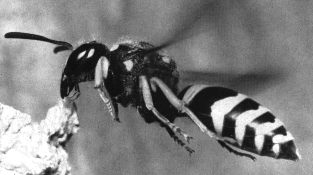 Insects in the Big Picture
Insects in the Big Picture
More than 110,000 species of ants, wasps, and bees are known. The name Hymenoptera is derived from the membranous quality of the wing ('hymeno-ptera' = 'membrane-wings'). The importance of bees to the pollination of plants is well known. Among many ant species, only the females have wings, for which anyone who lives in the tropics may be thankful. Some 'ants' are actually wingless wasp species.
The most striking aspect of the Hymenoptera is not their wings but their social behaviour.
The ants, wasps, and bees build large colonies, usually with a queen who is the sole producer of
offspring. Ants are capable of stunning feats of engineering and collaborate so efficiently that they seem
to be intelligent (although a cynic may argue that their lack of intelligence is precisely the reason
why ants work so well together). The members of a bee colony are all assigned special roles, tending the
larvae in their cells, searching for food and dancing when they've found it (more on that later), etc.
Besides the termites, which have the highest known protein-to-mass ratio and hence are good to eat,
there are no insects whose social behaviour is as familiar as that of the order Hymenoptera.

 Insects in the Big Picture...2.2, March 1996
Insects in the Big Picture...2.2, March 1996